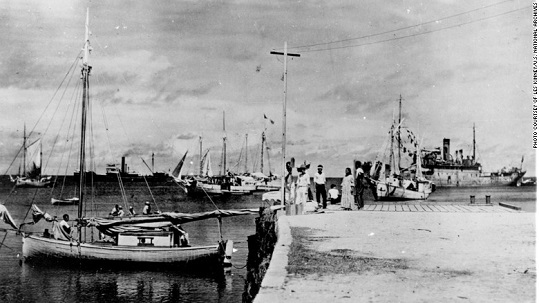Is she is, she’s now 120 years old, so it’s unlikely she’s still alive. This conclusion is especially compelling because she hasn’t been heard from since 1937. That’s a long time for a living person with no motive to go into hiding to completely disappear. We can safely assume she’s dead.
Exactly what happened to Earhart and Fred Noonan, her navigator, is unknown. They vanished while flying across the Pacific. The three main theories about their fate are:
(1) They strayed off course, ran out of fuel, and crashed at sea.
(2) They were marooned on a deserted island and died there.
(3) They were captured and executed by the Japanese.
Japan says it has no record of them. Of course, not all Japanese records survived the war, but keep in mind that Japan and the U.S. weren’t at war or formal enemies in 1937, although that doesn’t mean the Japanese military would treat kindly Americans it considered spies. However, this theory garnered some new attention last week when the following photo surfaced:
That’s purportedly Earhart sitting on the dock, back to camera, and Noonan standing at the left, next to the utility pole, with their plane in tow behind the Japanese ship in the background. Good luck with that interpretation. Do you see any captives in this photo? All I see on the dock is some people casually hanging around, none of whom are in chains or under guard.
Let’s think about this for a minute. Earhart in her time was one of the world’s most famous people. When she went missing, the entire civilized world was curious what happened to her. How credible is it that Japanese authorities seized an American citizen of her prominence and held her incommunicado or killed her — in 1937? Not very. The simplest and most plausible explanation of why Japan has no record of her is that they didn’t have her.
So what did happen to her and Noonan? Given the vast expanses of the Pacific Ocean and the primitive navigation methods of the day, a reasonable inference from the fact they never showed up at their intended destination is that they wandered off course and ended up somewhere else.
That’s exactly what happened to my uncle, a B-24 pilot. On his last flight, he took off from an airfield near Manila for a 400-mile trip to his home base on Leyte Island. My family knows what happened to him because native hunters stumbled across the wreckage in the 1950s. Flying in bad weather, he was 25 miles off his plotted course, putting him over Leyte Island’s interior instead of its coastline, and he flew into a mountain, probably while descending for final approach to the runway, and his plane then disappeared under jungle growth.
Given the relative proportions of water and land where Earhart and Noonan were flying, they most likely ditched in the ocean, but if they were lost and low on fuel they naturally would make for any land they could see, so they could have reached an island. Then they would have to survive a crash landing or ditching, and then manage to live off the land. The odds would be stacked against them, and we can infer from the fact they were never heard from again that they didn’t beat the odds.
Earhart and Noonan may have taken off with less than a full load of fuel due to a preflight mistake (there’s some suggestion of that) and simply run out of gas short of landfall. If they were off course, they probably wouldn’t realize it until the time to arrive at their destination had come and gone, with no destination in sight, at which point they would be nearly out of fuel and would make for any land they could see.
Like my uncle, they probably fell victim to the imprecise navigation methods of those times, and then just ran out of luck. For the other side of the argument, see this story.
